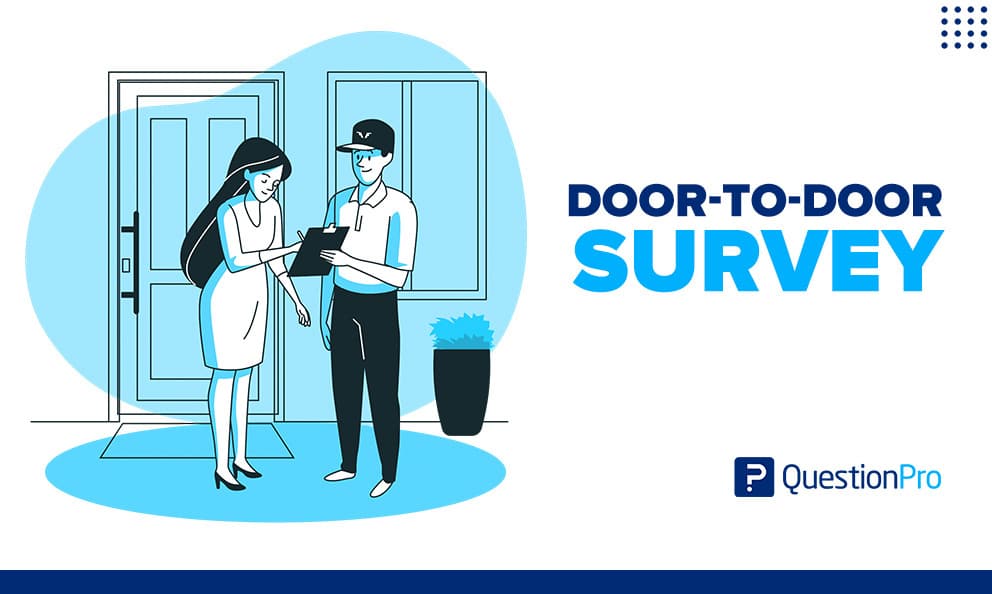 Reading Time: 3 minutes read
Reading Time: 3 minutes readWhen it comes to conducting surveys, today’s market researchers have a wide selection of modern tools and technologies. It’s easy to overlook the older methods for collecting data, but meaningful research was conducted long before email and online surveys arrived. Those ‘low-tech’ approaches have well-established benefits that may be worth considering. One such approach is the Door-to-Door survey.
In this type of survey, market research is conducted face-to-face at the respondent’s home or place of business. This method is a form of direct qualitative research conducted in real-time, and there are some significant reasons you may want to consider this approach.
LEARN ABOUT: Survey Mistakes And How to Avoid
What is a Door-to-Door survey?
A Door-to-Door survey is a study designed to target residents of a specific region or community – often referred to as ‘geodemographics.’ By conducting a door-to-door survey, researchers can be sure to solicit responses/data from an isolated audience. A great example would be a transportation authority soliciting feedback on a proposed road project affecting a specific community.
Door-to-Door surveys are also critical for ensuring data collection from respondents who might otherwise be unlikely or unable to participate in other survey methodologies, such as surveys that are conducted online and delivered via email.
Door-to-Door surveys may be the only way to adequately collect data from communities of senior citizens or lower-income neighborhoods which may not have access to reliable internet. Relying solely on online surveys means your data would exclude these crucial demographics.
Advantages and Disadvantages
While there are some clear examples of studies where a Door-to-Door survey would be ideal, it is essential to weigh the advantages and disadvantages of conducting face-to-face research.
On the positive side, conducting a survey Door-to-Door creates a 1-on-1 relationship that allows the interviewer to take a personalized approach, building rapport with the respondent and establishing trust. This may lead to more honest responses and enable the interviewer to tailor follow-up questions to the individual respondent.
It’s also much easier to conduct a service or product demonstration. The researcher benefits from collecting both verbal and non-verbal feedback from the respondent.
Conducting Door-to-Door surveys is not without its limitations. The most apparent drawback of this approach is cost. Door-to-Door survey campaigns are labor-intensive and time-consuming. It’s critical that interviewers are trained and professional, and they have a lot of ground to cover to collect adequate samples.
It may be challenging to catch respondents while they’re at home, and if they are home, they could be facing distractions from within their household. Additionally, some respondents may be reluctant to provide honest answers to socially-sensitive questions when face-to-face with a stranger.
How to conduct a Door-to-Door Survey
Despite these drawbacks, you may decide that a Door-to-Door survey is the only methodology to ensure you’ve collected data from a critical geodemographic. One approach would be to send your interviewers door-to-door in a specific community or neighborhood, but you may also decide to let the respondents come to you.
Setting up a booth or kiosk at a community center, grocery store, or another high-traffic area would allow the demographic to come to you. If you decide to proceed with either approach, QuestionPro has you covered:
- You can manage data in both offline and online modes. Its an easy task to do a Door-to-Door survey using QuestionPro offline survey app. QuestionPro offline app allows you to collect data in just a few clicks. Ask the questions to the interviewee and select those options in the pre-defined questionnaire on the app.
- Once the interview is over, submit the response and later sync it with the online account. These responses can later be analyzed using different analytical features. If you happen to meet physically challenged people, you can use the QuestionPro app’s speech-to-text feature.
- Topline features that are readily available with the apps are Text to Speech, Location data, Captured images, and audio.
QuestionPro offline app is available on both Android and iOS devices; you can install it on tablets, iPads, and Mobile phones. One single organization can have as many device keys for their devices.
Throughout the pandemic, researchers widely used the QuestionPro app to study and collect data from Covid affected people. Investigators collected feedback from these people, got good responses and data, and shared it with the local government to take appropriate actions later.
Regardless of how you decide to approach your Door-to-Door survey campaign, consider QuestionPro, a partner to ensure your success.
Schedule an online demo with our consultants if you are interested in conducting a door-to-door survey and would like to use digital surveys to speed up this process.
QuestionPro offers the perfect mobile app survey tool to collect f2f survey data from your customers.
Authors: Manoj Kumar and Travis Wolf




















